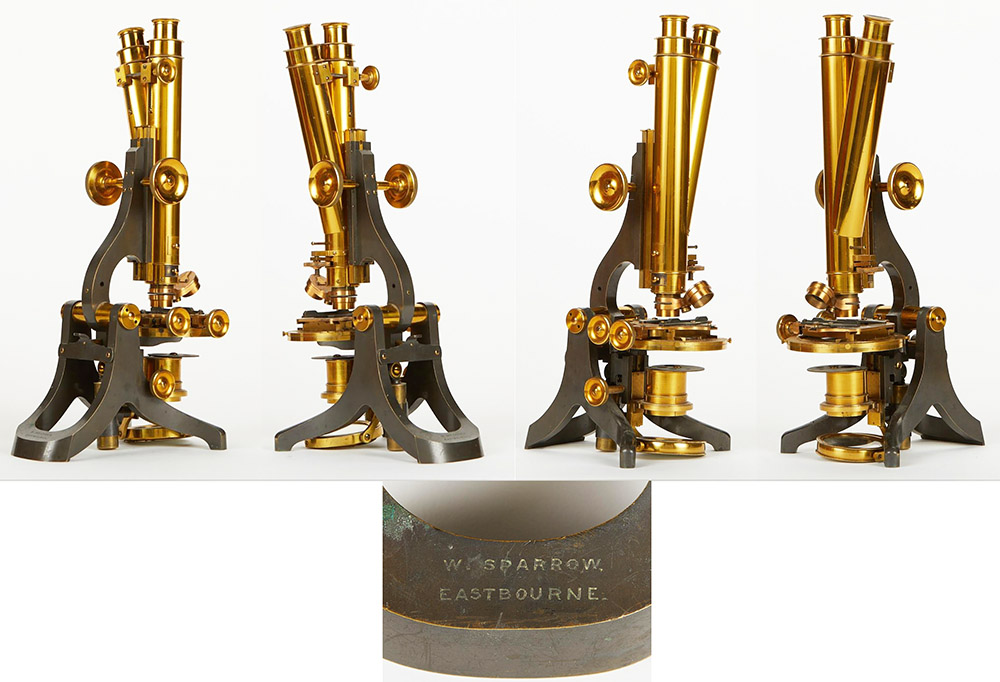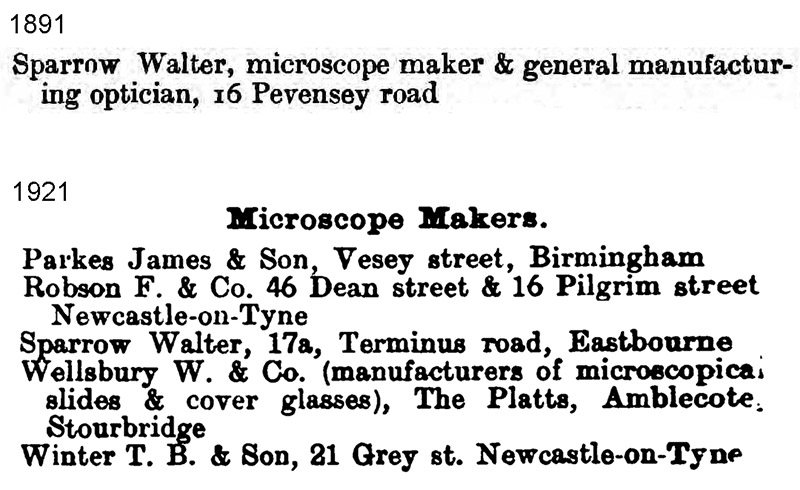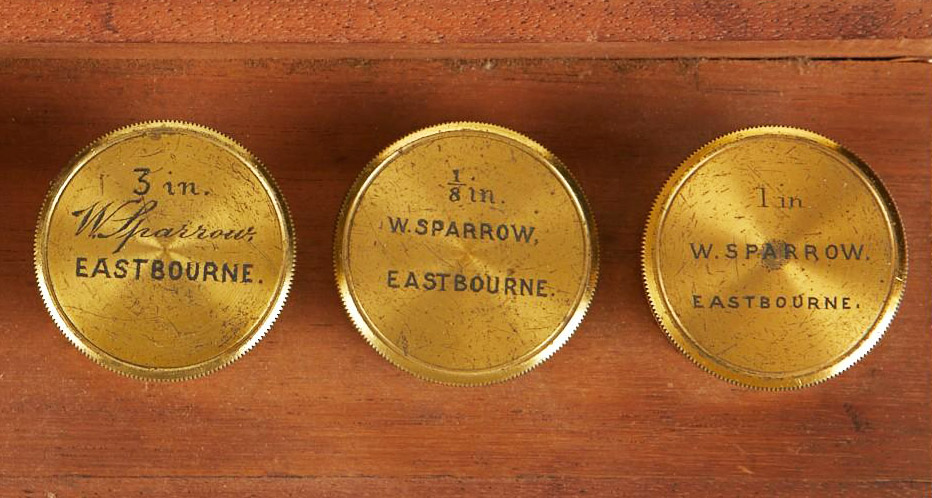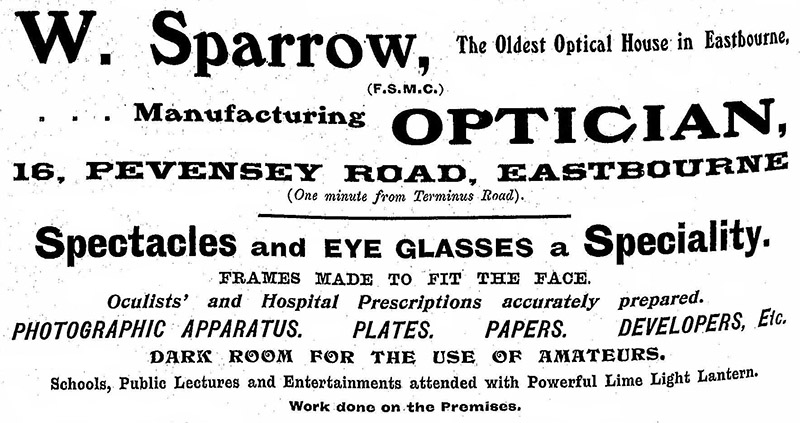
Figure 1. The only known microscope that is signed by Walter Sparrow. It appears to be identical to the "Challenge" model that was made by J. Swift & Son in 1880 (Figure 2). Adapted for nonprofit, educational purposes from an internet auction site.
Walter Sparrow, 1847 - 1930
by Brian Stevenson
last updated January, 2022
Walter Sparrow was a "working optician", which is to say, he manufactured eyeglass lenses and other optical devices to order. Sparrow's shop in Eastbourne, Sussex, England, also sold microscopes, which many opticians' shops did in the 1800s. At least one microscope is known that is engraved with Sparrow's name and address (Figure 1). It appears to be identical to the "Challenge" model that was manufactured by J. Swift & Son in 1880 (Figure 2).
Swift and other major microscope manufacturers often sold their instruments wholesale "to the trade", with re-sellers occasionally placing their names onto such microscopes. That would be a logical assumption about the Sparrow microscope, but there is good evidence to suggest that Sparrow actually did make this microscope. Or, at least, he cleaned rough castings, polished and lacquered the brass, and assembled the microscope himself.
Sparrow advertised through his career that he was a "microscope maker". Yet, the 1881 national census listed that he employed just one boy, hardly enough to run a foundry to cast iron and brass.
An 1883 letter to the magazine Amateur Work provides a likely answer to the question of how Sparrow could have made microscopes in the 1880s:
"The following information with respect to the making of Microscopes may be interesting to some of the readers of Amateur Work. Happening to mention to an acquaintance of mine that I was about to make a set of patterns for a microscope, he advised me to do as he had done if I wished to save time and expense, that is to get a set of castings, etc., from a maker, I have seen the microscope since he has made it, and it is a really good serviceable instrument, quite sufficient to meet the requirements of any amateur microscopist. I have since obtained a complete set of castings, etc., for myself, together with tubes cut the exact length, rack and pinion for the focussing adjustments, eye-piece glasses, mirror, some black for blacking inside of tubes, etc.; also, some good lacquer for the bright parts, with necessary instructions how to put them together, for the moderate price of 16s. I obtained them from Mr. Sparrow, 6, Belitha Villas, Barnsbury, London, N., where the castings can be seen made up."
Hence, Sparrow had access to all the components necessary for a person to construct a microscope. Or, rather, he had "castings" and "tubes cut the exact length", along with "some black for blacking inside the tubes" and "lacquer for the bright parts". These parts would have required finishing by the purchaser. While it is possible that Sparrow cast all of these components himself, his employment of a single boy argues against that. The similarities between the Sparrow microscope shown in Figure 1 and Swift's productions suggests that Sparrow likely purchased the rough materials from Swift.
Additional circumstantial evidence to support that hypothesis comes from the 1871 national census. This was three years before Sparrow opened his own shop, but he worked as a "optician", and lived with his sister and brother-in-law at 5 Huntley Street, Tottenham Court. The J. Swift microscope factory was located at 43 University Street, Tottenham Court, which is about a 5 minute walk from Sparrow's home. All things considered, it is highly likely that Sparrow had worked for Swift before opening his own business. Through connections with his former employers, Sparrow obtained raw components, with which he constructed microscopes for sale in his shop. And, occasionally, sold such parts to do-it-yourselfers.
If those interpretations are accurate, then it is possible that other antique microscopes that are clearly recognizable as products of major manufacturers but bear other people's names might, to a certain extent, have actually have been made by the people who signed them.

Figure 1.
The only known microscope that is signed by Walter Sparrow. It appears to be identical to the "Challenge" model that was made by J. Swift & Son in 1880 (Figure 2). Adapted for nonprofit, educational purposes from an internet auction site.

Figure 2.
Illustrations of Swift's "Challenge model from his 1880 "Hints to the Uninitiated" (left) and his 1892 catalogue (right). The 1880 model has a fine focus that consists of a rotating knob that adjusts the height of the objective lens by moving a second tube inside the main body tube (as seen on the Sparrow microscope in Figure 1), whereas the later version has a micrometer screw set into the side of the body tube.

Figure 3.
Entries from trade directories indicate that Walter Sparrow declared himself to be a microscope maker in 1891 and 1921.

Figure 4.
Lids of objective lens canisters, signed by Walter Sparrow. Adapted for nonprofit, educational purposes from an internet auction site.
Walter Sparrow was born on April 6, 1847, on Brewer Street in the St. Pancras parish of London. He was the fourth of four known children of Frederick and Caroline Sparrow. Walter's baptism record described father Frederick's occupation as "grainer", that is, he used painting techniques to create the appearance of wood grain on furniture, walls, etc. He was evidently a good one and gained enough money to invest in property, because the 1861 census listed Frederick's occupation as "proprietor of houses".
As noted above, the 1871 census recorded that Walter was then an "optician", living with sister Rosa and her husband at 5 Huntley Street.
A later newspaper advertisement stated that Sparrow opened his shop in 1874. He married Elizabeth Duck on September 2, 1876, at St. Barnabas, Islington. He then lived, and presumably worked, at 39 Isledon Road, Islington. Their only child, a son, was born the following October. By the time of the 1881 national census, the Sparrows had moved to 6 Belitha Villas, Islington. As reported by our letter-writer, Sparrow's shop was at that address in 1883. As also noted above, Sparrow then employed a boy, who would have been useful for delivering orders and simple work such as polishing microscope components.
By 1891, Sparrow had move to 16 Pevensey Road, Eastbourne, Sussex. His shop was located in the family home. Wife Elizabeth was working as a "dress mantle maker". The Sparrows hosted three boarders that year, but also employed a live-in servant.
In 1898, Walter Sparrow was admitted to the Company of Spectaclemakers (guild).
Sparrow died on March 22, 1930.

Figure 5.
A 1901 advertisement from Walter Sparrow. He primarily made prescription eyeglasses. The initials that follow his name indicate that he was a Fellow of the Spectacle Maker's Company. Sparrow was an accomplished photographer, and also sold photographic equipment and supplies.
Concluding statement
I'm sorry, but I cannot resist pointing out that Mr. Sparrow, who married Miss Duck, probably worked for Mr. Swift!
Resources
Admission record of Walter Sparrow (1898) Worshipful Company of Spectaclemakers, accessed through ancestry.com
Amateur Work (1883) Microscopes (letter from "W.D."), Vol. 3, page 239
Baptism record of Walter Sparrow (1847) parish records of St. Pancras, accessed through ancestry.com
Eastbourne Gazette (1900) Advertisement from Walter Sparrow, January 24
England census and other records, accessed through ancestry.com
Kelly's Directory of The Chemical Industries (1921) Listing for Walter Sparrow, pages 237 and 718
Kelly's Directory of Sussex (1881) Listing for Walter Sparrow, page 2171
Kelly's Directory of Sussex (1909) Advertisement from Walter Sparrow, rear of book
Kelly's Directory of Sussex (1918) Listing for Walter Sparrow, page 917
Marriage record of Walter Sparrow and Elizabeth Duck (1876) parish records of St. Barnabas, Islington, accessed through ancestry.com
Probate of the will of Walter Sparrow (1930) "Sparrow Walter of 29 Hyde-road Eastbourne died 22 March 1930 at 1 College-road Eastbourne Probate Lewes 8 May to Walter Augustus Sparrow borough treasurer. Effects £1488 4s 3d", accessed through ancestry.com